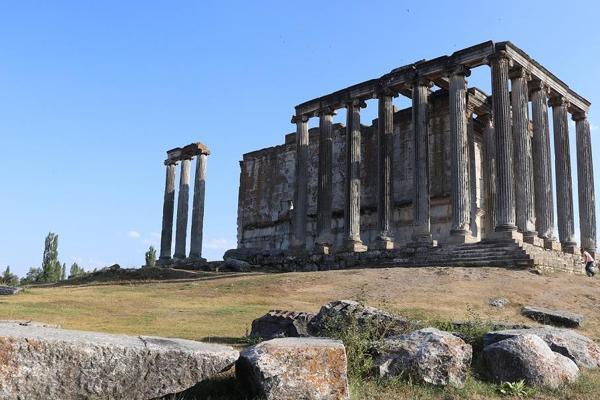Project to float boats in ancient city continues
KÜTAHYA


The name “Aizanoi” comes from the mythological hero “Azan.” The city is believed to date back to 3,000 B.C.
Within the scope of works carried out to float boats like in the ancient times, earth filled on Roman-era walls is being removed in the ancient city of Aizanoi in Çavdarhisar district of the western province of Kütahya.
The “Penkalas Project” is in progress in Aizanoi, which is home to the best-preserved Zeus Temple in Anatolia and known as the Second Ephesus.
As part of the project, the water level is being raised in the ancient city, which was included in the UNESCO World Heritage Tentative List in 2012.
Deputy head of the excavation and coordinator of the Penkalas Project, Fikret Aksoy said that the excavations, previously conducted by German archaeologists, had been carried out by Turkish archaeologists and experts from various universities for the last eight years.
Aksoy stated that the drawings of the Penkalas Project, which took its name from the ancient name of the stream, started in 2012, adding, “We will raise the water level by arranging the walls on both sides of this stream, known as Kocaçay. Here we aim to float boats like in the ancient times.”
Aksoy said that under the project the restoration work of the ancient Roman bridges in the stream still continued, too.
He said that about four months ago in the ancient city, they began to uncover the Roman walls, filling them with earth, on the edge of the stream.
“We made an inventory of the Roman walls. We extracted about 1,000 stone artifacts from the stream and made their inventories. The cost of the project is about 7 million Turkish Liras. This year we began to work with 1 million liras from the Culture and Tourism Ministry and 500,000 liras from the governor of Kütahya. In the current studies, we remove the filled earth in front of the stream wall. Afterwards, we will start drilling and the walls of the Roman period will be placed in their original places with the help of cranes. There will be walkways, recreation and exhibition areas. If the necessary appropriations are provided, the water level will be raised and the project will be completed,” Aksoy added.
He said the buildings, known as Çavdarhisar houses, used in the last period of the Ottoman Empire and the first years of the Turkish Republic, will be operated by the private sector as cafes and restaurants.
Aksoy stressed that tourism in the ancient city will be revived with the Penkalas Project, adding, “The fact that the boats will be floated on the stream and that there will be social and cultural structures around it will draw attention to the ancient city of Aizanoi. This situation will make great contributions to both the district and Turkey in terms of tourism. Today, there are examples of Venice and Eskişehir Porsuk Creek passing through the middle of the city, but this is the first and only one in the world because it is a project that passes through the middle of an ancient city and where boats can be floated.”
